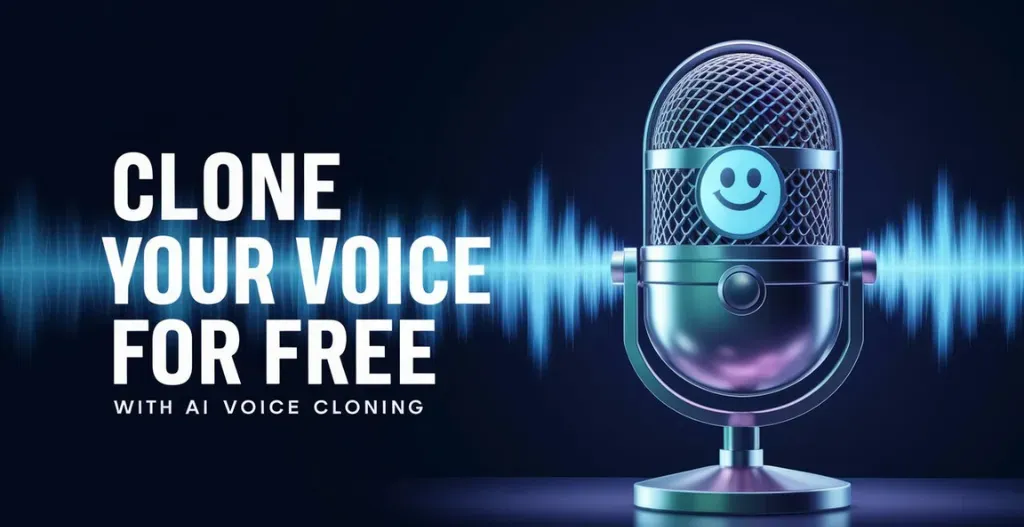Artificial intelligence (AI) is changing the way how we use today’s technology, and one of the coolest developments is AI Voice Cloning. Imagine being able to copy your voice with incredible accuracy and use it in many creative ways—from making personalized audio messages to adding voiceovers in videos. With AI voice cloning, this is now possible, and the best part is, you can learn to do it for free! Whether you’re a content creator, interested in voice acting, or just curious about how it works, exploring voice cloning can lead to new ways to express yourself.
In this article, we’ll cover the basics of AI voice cloning, introduce you on how to clone your voice for free, and will also provide easy steps to help you get started. Get ready to discover how simple it can be to clone your own voice using AI!

What Is AI Voice Cloning?
AI Voice Cloning is a powerful technology that allows you to create a highly accurate digital copy of someone’s voice. By using artificial intelligence, the system listens to recordings of a person’s voice and learns its unique sound, tone, and speech patterns. Once it understands these details, it can then generate speech that sounds just like the original person, even without them actually speaking.
This opens up endless possibilities. For example, you could use your cloned voice for voiceovers in videos, create personalized audio messages, or even develop unique content for podcasts or animations. Voice cloning can also be helpful for people who might lose their voice due to medical conditions, allowing them to preserve and continue using it.
The exciting part is that modern AI tools have made this technology accessible, meaning you don’t need expensive equipment or software to clone a voice. With free tools available online, anyone can experiment with voice cloning, from content creators and aspiring voice actors to people simply interested in exploring how AI can recreate human voices.

How Does AI Voice Cloning Work?
AI voice cloning works by using advanced technology to listen to your voice, learn its unique features, and then create a digital copy of it. Here is how AI voice cloning works:
- Recording Your Voice: You start by recording samples of your voice, usually by reading a few sentences or more.
- AI Analyzes Your Voice: The AI listens to your recording and studies things like your tone, pitch, accent, and the way you pronounce words.
- Creating the Clone: After learning from your voice, the AI creates a digital version that sounds just like you.
- Using the Clone: Once the clone is made, you can type out sentences, and the AI will “speak” them in your voice.
This whole process allows you to create a voice that can say anything in your unique style, just like if you were speaking yourself!
Benefits of Voice Cloning :
Voice cloning offers several benefits, especially with AI making it easy and accessible. Here are some of the key advantages in simple terms:
- Personalized Content : You can create custom audio messages, narrations, or voiceovers using your own voice, making the content feel more personal.
- Saving Time : Once you clone your voice, you don’t have to record every time. Just type what you want to say, and the AI will speak it in your voice.
- Creative Flexibility : It allows for creative projects like voiceovers for videos, podcasts, or storytelling, all in your unique voice.
- Voice Preservation : You can preserve your voice for future use, which can be useful for people who may lose their ability to speak.
- Accessibility : It can help people with speech impairments by letting them use their cloned voice to communicate.
- Cost-Effective : Instead of hiring a voice actor, you can use your own cloned voice, saving money in projects like commercials or apps.
Voice cloning offers a fun and practical way to use your voice in many creative and useful ways!
What are the Common Use Cases for AI Voice Cloning?
Voice cloning has several practical and creative uses. Here are some common ones:
- Content Creation: You can use your cloned voice for videos, podcasts, or social media content, making it easier to create voiceovers without recording each time.
- Personalized Messages: Send customized audio messages to friends, family, or clients using your voice, even if you’re not available to record.
- Voice Acting: Aspiring voice actors can create samples or try different styles without re-recording, saving time and effort.
- Gaming and Animation: Developers and creators can give characters unique voices quickly by cloning real voices and applying them to different projects.
- Assistive Technology: Voice cloning can help those who are losing their voice due to illness, allowing them to continue communicating in their own voice through devices.
- Customer Service: Businesses can use cloned voices in virtual assistants, chatbots, or automated phone systems, making interactions feel more personal.
- Language Learning and Education: Educational apps can use cloned voices to create personalized lessons or repeat instructions in a familiar voice.
These are just a few ways voice cloning is used to save time, improve creativity, and enhance communication.
How to Use AI Cloned Voices Legally?
Using cloned voices legally means making sure you’re following the rules and respecting people’s rights. Here are a few simple guidelines:
- Get Permission: If you want to clone someone else’s voice, you must ask for their permission first. Using someone’s voice without consent can get you into legal trouble.
- Use Your Own Voice: If you’re cloning your own voice, you’re free to use it however you like, but be careful not to mislead others into thinking it’s someone else.
- Don’t Mislead or Harm: Avoid using cloned voices to deceive, impersonate, or harm others. For example, don’t use a cloned voice to trick people into thinking you’re someone else.
- Respect Copyright Laws: If you’re using voice cloning for creative projects, make sure you’re not copying voice performances that are protected by copyright.
By following these rules, you can enjoy the benefits of AI voice cloning without any legal issues.
Steps to Clone Your Voice For Using AI Voice Cloning :

Here’s a simple step-by-step guide to clone your voice using Speechify’s AI voice cloning feature:
- Step 1 : Head over to Speechify.com
- Step 2 : Choose “AI Voice Cloning“ under the AI Voice Generator section and pick your language from over 40 options.
- Step 3 : Login or Signup to Speechify using your details.
- Step 4 : Select “Record Your Voice” or “Import From Your Device” to provide a voice sample.
- Step 5 : Scroll down and enter your name for the digital signature.
- Step 6 : In the Generate Audio step, choose the output language you want for the cloned voice.
- Step 7 : Enter the text you want the cloned voice to speak, then click “Clone Audio”.
- Step 8 : Once ready, you can share or download your AI cloned voice.
Congratulations! You’ve successfully cloned your voice with AI.
Conclusion :
AI voice cloning is an exciting and accessible technology that lets you create a digital version of your voice with impressive accuracy. Whether you’re interested in making personalized audio messages, adding voiceovers to videos, or exploring creative projects, voice cloning offers endless possibilities.
With free tools like Speechify, it’s easy to get started. By following simple steps, you can record your voice, create a digital clone, and use it for various purposes. Just remember to use this technology responsibly by respecting permissions and avoiding deception.
Enjoy experimenting with your new cloned voice and see how it can enhance your projects and communication!
Checkout Build an AI Influencer from Scratch: Guide to Create Your AI Model
Discover more from Owrbit
Subscribe to get the latest posts sent to your email.










